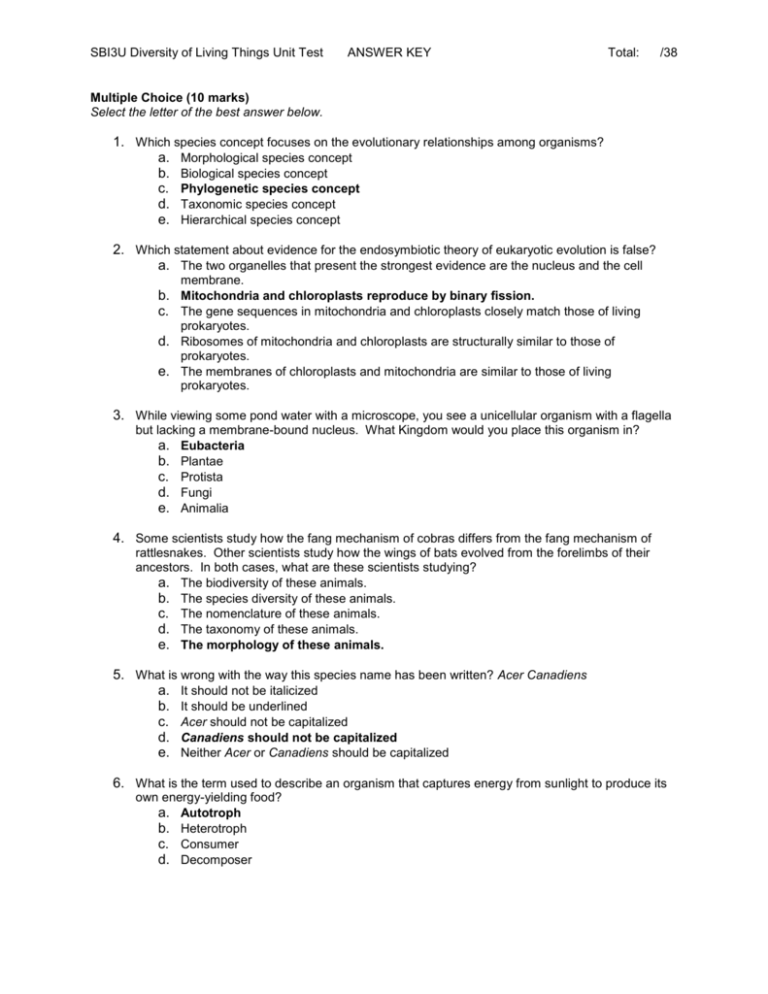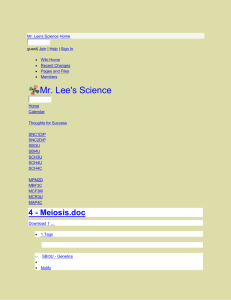SBI3U Biology: Diversity of Life Unit Test Answer Key
advertisement

SBI3U Diversity of Living Things Unit Test ANSWER KEY Total: /38 Multiple Choice (10 marks) Select the letter of the best answer below. 1. Which species concept focuses on the evolutionary relationships among organisms? a. Morphological species concept b. Biological species concept c. Phylogenetic species concept d. Taxonomic species concept e. Hierarchical species concept 2. Which statement about evidence for the endosymbiotic theory of eukaryotic evolution is false? a. The two organelles that present the strongest evidence are the nucleus and the cell membrane. b. Mitochondria and chloroplasts reproduce by binary fission. c. The gene sequences in mitochondria and chloroplasts closely match those of living prokaryotes. d. Ribosomes of mitochondria and chloroplasts are structurally similar to those of prokaryotes. e. The membranes of chloroplasts and mitochondria are similar to those of living prokaryotes. 3. While viewing some pond water with a microscope, you see a unicellular organism with a flagella but lacking a membrane-bound nucleus. What Kingdom would you place this organism in? a. Eubacteria b. Plantae c. Protista d. Fungi e. Animalia 4. Some scientists study how the fang mechanism of cobras differs from the fang mechanism of rattlesnakes. Other scientists study how the wings of bats evolved from the forelimbs of their ancestors. In both cases, what are these scientists studying? a. The biodiversity of these animals. b. The species diversity of these animals. c. The nomenclature of these animals. d. The taxonomy of these animals. e. The morphology of these animals. 5. What is wrong with the way this species name has been written? Acer Canadiens a. It should not be italicized b. It should be underlined c. Acer should not be capitalized d. Canadiens should not be capitalized e. Neither Acer or Canadiens should be capitalized 6. What is the term used to describe an organism that captures energy from sunlight to produce its own energy-yielding food? a. Autotroph b. Heterotroph c. Consumer d. Decomposer SBI3U Diversity of Living Things Unit Test ANSWER KEY Total: /38 7. In vascular plants, xylem allows for which process? a. Transport of large molecules like sugar from the roots. b. Transport of water and minerals from root systems. c. Gas exchange that occurs in the leaves. d. Absorption of sunlight to help with photosynthesis. e. Storage of food in the form of glycogen. 8. Which statement about viruses is true? a. They contain only RNA. b. They replicate only in eukaryotic cells. c. They cannot replicate independently outside of a living cell. d. They cause disease but only in humans. e. They contain membrane-bound organelles. Short Answers Answer the questions below. Point form is acceptable. 9. List three (3) differences between prokaryotic and eukaryotic cells. (3 marks) Prokaryotic cells do not have a membrane-bound nucleus, whereas eukaryotic cells do. Eukaryotic cells have a more complex internal structure than prokaryotic cells (the presence of organelles), and are about 1000x larger. 10. A pitcher plant (Sarracenia purpurea) is an Ontario bog plant with leaves that hold water in which various organisms live. Is a pitcher plant a species or an ecosystem? Explain your answer. (2 marks) An ecosystem consists of all the biotic and abiotic components in a given area interacting with one another. Thus, a pitcher plant itself would not be an ecosystem, as the soil and sunlight in the area are also part of the ecosystem. It is species instead. 11. As birds evolved they developed the ability to fly, which gives them much greater mobility than most animals. How are laying and incubating eggs outside of the body an adaptation for flying? (2 marks) Laying and incubating eggs outside of the body became an adaptation because it is difficult to fly with eggs inside the body, as the weight is too heavy. The ability to fly would be a useless adaptation if birds were immobilized during reproductive seasons. SBI3U Diversity of Living Things Unit Test ANSWER KEY Total: 12. Use the table below to answer the following questions. (2 marks) 1a. Skin without spots .......................................go to 2 1b. Skin with spots ........................................go to 4 2a. Found under cover in or beside streams......................... two-lined salamander 2b. Found in forests ................................................... go to 3 3a. Red stripe down back ............................................. red-backed salamander 3b. Grey-black overall ............... red-backed salamander (black variant) 4a. Bright red small spots ....................................... go to 5 4b. Blue or yellow spots ....................................... go to 6 5a. Green overall, found in aquatic ecosystems .................................................. red-spotted newt 5b. Reddish overall, found in terrestrial ecosystems ..............................red-spotted newt juvenile (“red eft”) 6a. Many irregular blue spots ...........blue-spotted salamander 6b. Large yellow spots ....... yellow-spotted salamander a. What is the organism in the image? red-spotted newt juvenile (“red eft”) b. What is the name of this taxonomic tool? dichotomous key 13. Draw a phylogenetic tree that shows the following scenario: Bacteria and Archaea diverged from a common ancestor relatively soon after life began on Earth. Later, Eukarya split off from the archaeal line, implying that Eukarya are more closely related to Archaea than to Bacteria. (3 marks) Bacteria Archaea Eukarya common ancestor 14. Label the diagram below by filling in the corresponding blanks below. /38 SBI3U Diversity of Living Things Unit Test ANSWER KEY Total: 3 2 4 1 5 6 1._______lyses________ 4. __lysogenic__________ 2.______lytic__________ 5. ___prophage__________ 3._bacterial chromosome_ 6. __recombination________ 15. If you were a scientist developing a drug that would block viral replication, which step would you choose to block? Explain your answer. Refer to the diagram above. (2 marks) Answers may vary. For example: I would try to block the first step, in which the phage attaches to the host cell and injects DNA. I would block attaching, as it would prevent invasion of the bacteria, and thus prevent the virus from replicating inside. Data Analysis Refer to the data below to answer the following question. /38 SBI3U Diversity of Living Things Unit Test ANSWER KEY Total: /38 16. Define resilience with respect to ecosystems. (1 mark) Resilience is the ability of an ecosystem to remain functional and stable in the presence of Plant Species Diversity and Percentage of Plant Coverage Plant Species Diversity and Number of Invasive Species Plant Species Diversity and Disease Severity disturbances to its parts. 17. Use all three graphs above to explain how ecosystem resilience is affected by plant species diversity. (3 marks) The greater the plant species diversity, the greater the percentage of total plant coverage in an area. This is an indication of abundance, which relates to resilience because a greater abundance of species affords greater population increase. The greater the plant species diversity, the decrease in percentage of number of invasive species, and the greater the resilience because plants have less risk of competing with or being harmed by invasive species. The greater the plant species diversity, the lesser the disease severity index and the greater the resilience because diseases are less severe to plants, which increases plants’ chances of survival. Essay Answer ONE (1) of the following questions. Use full sentences. 18. a. Human activities affect the diversity of living things in ecosystems. By creating extreme SBI3U Diversity of Living Things Unit Test ANSWER KEY Total: /38 environments, such as water or soil that contains high amounts of toxins or acid, are we encouraging the evolution of new archaea? What would be the positive and the negative consequences of this? (6 marks) OPINION: Yes, we are encouraging their evolution. SUPPORTS: - Arachae have relatively short life spans & reproduce asexually, allowing for more generations to be produced in a short period of time, encouraging more spontaneous mutation (an ultimately evolution) over that period of time. - Extreme environments encourage evolutionary selections of species towards that extreme (ex. acidic environments select for organisms with possess traits which make them more resistant to acid) PROS: - this would potentially increase biodiversity by creating new species, as those with certain adaptive traits branch off from a common ancestor - this could be a positive as we may be able to gain new resources from these new species, for medicine, food, etc. - newly created species could become a food source for other species (in addition to humans), or create new niches for further speciation to occur CONS: - the creation of new archae species could potentially decrease biodiversity if the new species competes for resources with existing species. - new species also have the potential to create toxic byproducts (instead of useful resources) [Other well-supported arguments are possible] b. Many Canadian birds set the timing of their spring migration to the photoperiod (the amount of daylight each day). This system has allowed them to return at the correct time each spring. The photoperiod does not change from year to year, and it is not affected by global warming. What might happen if spring arrives earlier due to global warming, but birds continue to set the timing of their spring migration to the photoperiod? (6 marks) - Birds return to regions in the spring at the time that allows them to take full advantage of the food sources in the area. - If spring starts early then plants the birds use for food will start growing earlier as well. - This could mean other animals that don’t migrate would get to eat the food sources first. - This could also mean that food sources might be at a stage of rotting (or no longer fruit bearing) by the time the birds reach them. - Because of these contributing factors (and other possible well-supported factors) birds may NOT be able to take full advantage of the plant resources that their photoperiod once allowed them. - Birds species who do not arrive early enough to gain significant/lasting nutrition from these resources, as they once did, may become EXTINCT. [Other well-supported answers possible]









